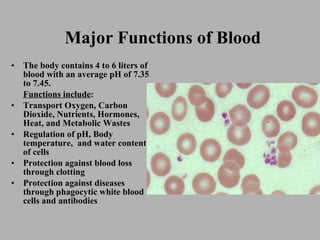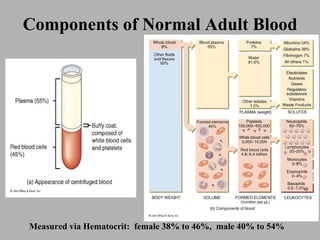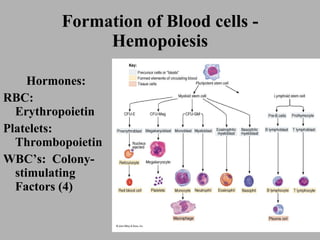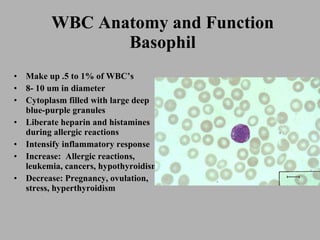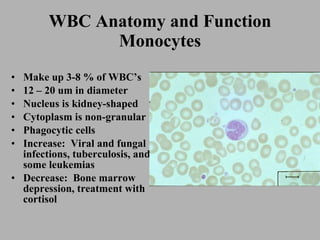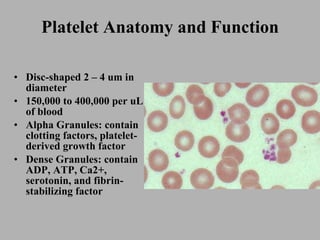Wbc structure and functions
- 1. Major Functions of Blood The body contains 4 to 6 liters of blood with an average pH of 7.35 to 7.45. Functions include : Transport Oxygen, Carbon Dioxide, Nutrients, Hormones, Heat, and Metabolic Wastes Regulation of pH, Body temperature, and water content of cells Protection against blood loss through clotting Protection against diseases through phagocytic white blood cells and antibodies
- 2. Components of Normal Adult Blood Measured via Hematocrit: female 38% to 46%, male 40% to 54%
- 3. Abnormal Hematocrits Polycythemia : Increased RBC production. Physiologic Polycythemia: Increase in RBC production due to hypoxic tissues, like what occurs at high altitudes. Polycythemia Vera: genetic mutation in the hemocytoblastic cell line that increases RBC production. Hematocrit values can reach 70%
- 4. Components of Normal Adult Blood
- 5. Formation of Blood cells - Hemopoiesis Hormones: RBC: Erythropoietin Platelets: Thrombopoietin WBCŌĆÖs: Colony-stimulating Factors (4)
- 6. Red Blood Cells or Erythrocytes Contain hemoglobin to carry oxygen 4.8 to 5.4 million RBCŌĆÖs per microliter Produced at a rate of 2 million RBCŌĆÖs per second Lack a nucleus Biconcave to increase surface/volume ratio Diameter of 7 ŌĆō 8 microns
- 7. RBC Shape and the Structure of Hemoglobin RBCŌĆÖs pass through capillary beds in single file. Hemoglobin is made of four polypeptides: Two Alpha and two Beta that contain a heme unit Each heme can carry an O2 There are about 280 million hemoglobin molecules in each RBC Other molecules such as CO2 and NO are also carried by hemoglobin
- 8. Formation and Destruction of RBCŌĆÖs
- 9. Changes in hemoglobin Anemia: A deficiency of RBCs, which can be caused by either too rapid loss or slow production. Blood loss Anemia: Due to hemorrhage, plasma is replaced in 1-3 days, but, RBC replacement takes longer. Microcytic Hypochromic Anemia: Low levels of hemoglobin in RBCs due to chronic blood loss resulting in low Fe3+ levels in newly produced RBCs. Aplastic Anemia: Decreased RBC production in bone marrow due to chemical, drug, or radiation exposure. Pernicious Anemia: C hronic illness caused by impaired absorption of Vitamin B-12 because of a lack of intrinsic factor (IF) in gastric secretions . Vitamin B12, in turn, is necessary for the formation of red blood cells.
- 10. Changes in Hemoglobin Anemia: A deficiency of RBCs, which can caused by either too rapid loss or slow production. Hemolytic Anemia: Different abnormalities of RBCs that make RBCs fragile and rupture easily. Hereditary Spherocytosis : RBC develop as small spherical cells rather than being biconcave. These spherical cells easily rupture by slight compression. Sickle-cell Anemia : Genetic mutation causing abnormal beta chains. When this hemoglobin is exposed to low O2 concentrations, it precipitates into long crystals that cause the cells to become sickle-shaped.
- 11. ABO Blood Types 100 10 21 38 31 Japanese 20 27 100 1 4 16 79 Native Am. 100 6 25 27 42 Chinese 100 10 30 28 32 Korean 95 4 49 African Am. 85 4 11 40 45 White Rh AB B A O Group
- 12. Hemolytic Disease of Newborns (HDN) or Erythroblastosis Fetalis
- 13. WBC Anatomy and Function Neutrophil Make up 60 to 70% of WBCŌĆÖs 10 ŌĆō12 um. In diameter Nucleus 2-5 lobes (increase with cell age) Fine granular cytoplasm Phagocytic cells the engulf bacteria Increase: stress, burns, bacterial infections Decrease: Radiation exposure, B12 deficiency
- 14. WBC Anatomy and Function Eosinophil Make up 2-4% of WBCŌĆÖs 10 ŌĆō12 um in diameter Nucleus 2ŌĆō3 lobed Cytoplasm filled with large red granules Combat histamines in allergic reactions Phagocytic on antigen/antibody complexes Destroy certain parasitic worms Increase: allergic reactions, parasitic infections, autoimmune disease
- 15. WBC Anatomy and Function Basophil Make up .5 to 1% of WBCŌĆÖs 8- 10 um in diameter Cytoplasm filled with large deep blue-purple granules Liberate heparin and histamines during allergic reactions Intensify inflammatory response Increase: Allergic reactions, leukemia, cancers, hypothyroidism Decrease: Pregnancy, ovulation, stress, hyperthyroidism
- 16. WBC Anatomy and Function Monocytes Make up 3-8 % of WBCŌĆÖs 12 ŌĆō 20 um in diameter Nucleus is kidney-shaped Cytoplasm is non-granular Phagocytic cells Increase: Viral and fungal infections, tuberculosis, and some leukemias Decrease: Bone marrow depression, treatment with cortisol
- 17. WBC Anatomy and Function Lymphocytes Make up 20 to 25% WBCŌĆÖs Small: 6-9 um in diameter Large: 10-14 um Nucleus is round or slightly indented Cytoplasm forms rim around nucleus B cells produce antibodies T cells attack viruses, cancer cells, and transplanted tissues Natural killer cells attack infectious microbes and tumor cells
- 18. WBC Anatomy and Function Lymphocytes Increase: Viral infections and some leukemias Decrease: Prolonged illness, immunosuppression
- 19. Platelet Anatomy and Function Disc-shaped 2 ŌĆō 4 um in diameter 150,000 to 400,000 per uL of blood Alpha Granules: contain clotting factors, platelet-derived growth factor Dense Granules: contain ADP, ATP, Ca2+, serotonin, and fibrin-stabilizing factor
- 20. Steps in Vascular Damage and Clotting Responses Vascular Spasm: contraction of smooth muscle in arteriole walls to reduce blood flow. Platelet plug formation : 1. Platelet adhesion: Platelets contact and stick to free collagen fibers of the damaged blood vessel 2. Platelet release reaction: Activated platelets extend many projections that enable them to contact and interact with one another. They then liberate their granules.
- 21. Steps in Vascular Damage and Clotting Responses Liberated ADP and thromboxane A2 help activate other platelets. Serotonin and thromboxane A2 function as vasoconstrictors helping to decrease blood flow. 3. Platelet aggregation: Liberated ADP makes new platelets sticky; these newly-recruited and activated platelets adhere to the originally-activated platelets. The process causes the formation of a platelet plug.
- 22. The Blood Clotting Cascade Extrinsic Pathway (Fast acting) 1. Tissue Factor (TF) or Thromboplastin is released by tissue cells outside of the damaged vessel. 2. TF begins a chemical reaction pathway that activates Thrombokinase (F10). F10 combines with Proaccelerin (F5) to form the enzyme Prothrombinase.
- 23. The Blood Clotting Cascade Intrinsic Pathway (slow acting) Activated by factors within the blood or vessels Antihemophilic factor D or Hageman factor (F12) is activated by contact with collagen fibers. F12 starts a chemical cascade that ultimately activates F10 or Thrombokinase. F10 combines with Proaccelerin (F5) to form the enzyme Prothrombinase.
- 24. The Blood Clotting Cascade The Common Pathway Prothrombinase catalyzes the conversion of Prothrombin (F2) to Thrombin. Thrombin converts the soluble plasma protein fibrinogen in the insoluble protein fibrin (loose threads). Thrombin also activates Fibrin Stabilizing Factor (F13) which converts the loose threads into stable threads.
- 25. The Problems with Clotting Cascade Hemophilia A: Deficiency of Factor VIII accounts for 85% cases. Almost exclusively in males. Females are usually carriers caused by a gene mutation on the ŌĆ£XŌĆØ chromosome. Occurs in about 1/10,000 male births Other Hemophilias account for another 15% Hemophilia B (Factor IX) Hemophilia C (Factor XI) Hemophilia D (Factor XII)
- 26. The Problems with Platelets and Abnormal Clotting Thrombocytopenia: Abnormally low levels of platelets. Usually below 50,000/ul of blood. In many cases, specific antibodies are produced against platelets destroying them Thrombus: Abnormal clot that develops in a blood vessel. Embolus: Free thrombic clots carried in the blood that usually get caught in arterioles in the brain, kidney, and lungs.

